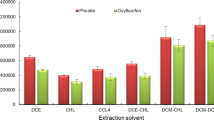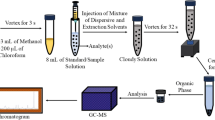Abstract
Solid-phase microextraction (SPME) was used to determine the equilibrium association constant for a pesticide, trifluralin (TFR), with dissolved organic matter (DOM). After optimization of the SPME method for the analysis of TFR, partition coefficients (K DOM) with three different sources of DOM were determined in buffered solutions at pH 7. Commercial humic acids and DOM fractions isolated from two surface waters were used. The values of log K DOM varied from 4.3 to 5.8, depending on the nature of the organic material. A good correlation was established between log K DOM and DOM properties (as measured with the H/O atomic ratio and UV absorbance), in agreement with literature data. This is consistent with the effect of polarity and aromaticity for governing DOM-pollutant associations, regardless of the origin of DOM. This association phenomenon is relevant to better understand the behavior of pesticides in the environment since it controls part of pesticide leaching and fate in aquatic systems.




Similar content being viewed by others
References
AFNOR NF T90-210 (2009) Water quality—protocol for the initial method performance assessment in a laboratory. Association Française de Normalisation (AFNOR), France, pp 1–43
Aguer JP, Richard C, Andreux F (1999) Effects of light on humic substances: production of reactive species. Analusis 27(5):387–390
Bachman J, Patterson HH (1999) Photodecomposition of the carbamate pesticide carbofuran: kinetics and the influence of dissolved organic matter. Environ Sci Technol 33(6):874–881
Bejarano AC, Chandler GT, Decho AW (2005) Influence of natural dissolved organic matter (DOM) on acute and chronic toxicity of the pesticides chlorothalonil, chlorpyrifos and fipronil on the meiobenthic estuarine copepod Amphiascus tenuiremis. J Exp Mar Biol Ecol 321(1):43–57
Boithias L, Sauvage S, Taghavi L, Merlina G, Probst J-L, Sánchez Pérez JM (2011) Occurrence of metolachlor and trifluralin losses in the Save river agricultural catchment during floods. J Hazard Mater 196:210–219
Carabias-Martínez R, García-Hermida C, Rodríguez Gonzalo E, Soriano-Bravo FE, Hernández-Méndez J (2003) Determination of herbicides, including thermally labile phenylureas, by solid-phase microextraction and gas chromatography-mass spectrometry. J Chromatogr A 1002(1–2):1–12
Carter WC, Suffet IH (1982) Binding of DDT to dissolved humic materials. Environ Sci Technol 16(11):735–740
Chen S, Inskeep WP, Williams SA, Callis PR (1994) Fluorescence lifetime measurements of fluoranthene, 1-naphthol, and napropamide in the presence of dissolved humic acid. Environ Sci Technol 28(9):1582–1588
Chiou CT, Malcolm RL, Brinton TI, Kile DE (1986) Water solubility enhancement of some organic pollutants and pesticides by dissolved humic and fulvic acids. Environ Sci Technol 20(5):502–508
Chiou CT, Kile DE, Brinton TI, Malcolm RL, Leenheer JA, MacCarthy P (1987) A comparison of water solubility enhancements of organic solutes by aquatic humic materials and commercial humic acids. Environ Sci Technol 21(12):1231–1234
Cox L, Celis R, Hermosin MC, Cornejo J, Zsolnay A, Zeller K (2000) Effect of organic amendments on herbicide sorption as related to the nature of the dissolved organic matter. Environ Sci Technol 34(21):4600–4605
Croué JP, Korshin GV, Benjamin M (1999) Isolation, fractionation and characterization of natural organic matter in drinking water. AWWA Research Foundation and American Water Works Association, Denver, 324p
De Paolis F, Kukkonen J (1997) Binding of organic pollutants to humic and fulvic acids: influence of pH and the structure of humic material. Chemosphere 34(8):1693–1704
Dimou AD, Sakkas VA, Albanis TA (2004) Trifluralin photolysis in natural waters and under the presence of isolated organic matter and nitrate ions: kinetics and photoproduct analysis. J Photochem Photobiol A Chem 163:473–480
Din JY, Wu SC (1995) Partition coefficients of organochlorine pesticides on soil and on the dissolved organic matter in water. Chemosphere 30(12):2259–2266
Ding Q, Wu H, Xu Y, Guo L, Liu K, Gao H, Yang H (2011) Impact of low molecular weight organic acids and dissolved organic matter on sorption and mobility of isoproturon in two soils. J Hazard Mater 190(1–3):823–832
Gauthier TD, Seltz WR, Grant CL (1987) Effects of structural and compositional variations of dissolved humic materials on pyrene KOC values. Environ Sci Technol 21(3):243–248
Holt MS (2000) Sources of chemical contaminants and routes into the freshwater environment. Food Chem Toxicol 38(Suppl 1):S21–S27
Ilani T, Schulz E, Chefetz B (2005) Interactions of organic compounds with wastewater dissolved organic matter: role of hydrophobic fractions. J Environ Qual 34(2):552–562
Konstantinou I, Hela DG, Albanis TA (2006) The status of pesticide pollution in surface waters (rivers and lakes) of Greece. Part I. Review on occurrence and levels. Environ Pollut 141(3):555–570
Kopinke F-D, Georgi A, MacKenzie K (2001) Sorption of pyrene to dissolved humic substances and related model polymers. 1. Structure-property correlation. Environ Sci Technol 35(12):2536–2542
Kubicki JD, Apitz SE (1999) Models of natural organic matter and interactions with organic contaminant. Org Geochem 30(8 B):911–927
Kulikova NA, Perminova IV (2002) Binding of atrazine to humic substances from soil, peat, and coal related to their structure. Environ Sci Technol 36(17):3720–3724
Labouyrie-Rouillier L (1997) Extraction et caractérisation des matières organiques naturelles dissoutes d’eaux de surface: Etude comparative des techniques de filtration membranaire et d’adsorption sur résines macroporeuses non ioniques. PhD thesis, Université de Poitiers
Landrum PF, Nlhart SR, Eadle BJ, Gardner WS (1984) Reverse-phase separation method for determining pollutant binding to Aldrich humic acid and dissolved organic carbon of natural waters. Environ Sci Technol 18(3):187–192
Lee S, Gan J, Liu WP, Anderson MA (2003) Evaluation of Kd underestimation using solid phase microextraction. Environ Sci Technol 37(24):5597–5602
Legube B, Croué JP, De Laat J, Doré M (1989) Ozonation of an extracted aquatic fulvic acid: theoretical and practical aspects. Ozone-Sci Eng 11(1):69–92
Li Q, Xu X, Lee FS-C, Wang X (2006) Determination of trace PAHs in seawater and sediment pore-water by solid-phase microextraction (SPME) coupled with GC/MS. Sci China Ser B 49(6):481–491
Lundqvist A, Bertilsson S, Goedkoop W (2012) Interactions with DOM and biofilms affect the fate and bioavailability of insecticides to invertebrate grazers. Ecotoxicology 21(8):2398–2408
MacKenzie K, Georgi A, Kumke M, Kopinke F-D (2002) Sorption of pyrene to dissolved humic substances and related model polymers. 2. Solid-phase microextraction (SPME) and fluorescence quenching technique (FQT) as analytical methods. Environ Sci Technol 36(20):4403–4409
Maloschik E, Ernst A, Hegedűs G, Darvas B, Székács A (2007) Monitoring water-polluting pesticides in Hungary. Microchem J 85(1):88–97
Martin-Mousset B, Croué JP, Lefèbvre E, Legube B (1997) Distribution et caractérisation de la matière organique dissoute d’eaux naturelles de surface. Water Res 31(3):541–553
Monteil-Rivera F, Brouwer EB, Masset S, Deslandes Y, Dumoncwater J (2000) Combination of X-ray photoelectron and solid-state 13C nuclear magnetic resonance spectroscopy in the structural characterisation of humic acids. Anal Chim Acta 424(2):243–255
Mott HV (2002) Association of hydrophobic organic contaminants with soluble organic matter: evaluation of the database of Kdoc values. Adv Environ Res 6(4):577–593
Ohlenbusch G, Kumke MU, Frimmel FH (2000) Sorption of phenols to dissolved organic matter investigated by solid phase microextraction. Environ Sci Technol 253(1–3):63–74
Pawliszyn J (1997) Solid phase microextraction: theory and practice. Wiley, New York, pp 11–41
Pinto MI, Sontag G, Bernardino RJ, Noronha JP (2010) Pesticides in water and the performance of the liquid-phase microextraction based techniques. A review. Microchem J 96(2):225–237
Poerschmann J, Kopinke F-D (2001) Sorption of very hydrophobic organic compounds (VHOCs) on dissolved humic organic matter (DOM). 2. Measurement of sorption and application of a Flory-Huggins concept to interpret the data. Environ Sci Technol 35(6):1142–1148
Poerschmann J, Kopinke F-D, Pawliszyn J (1997a) Solid phase microextraction to study the sorption of organotin compounds onto particulate and dissolved humic organic matter. Environ Sci Technol 31(12):3629–3636
Poerschmann J, Zhang Z, Kopinke F-D, Pawliszyn J (1997b) Solid phase microextraction for determining the distribution of chemicals in aqueous matrices. Anal Chem 69(4):597–600
Prosen H, Fingler S, Zupancic-Kralj L, Drevenkar V (2007) Partitioning of selected environmental pollutants into organic matter as determined by solid-phase microextraction. Chemosphere 66(8):1580–1589
Sánchez-Camazano M, Sánchez-Martín MJ, Poveda E, Iglesias-Jiménez E (1996) Study of the effect of exogenous organic matter on the mobility of pesticides in soils using soil thin-layer chromatography. J Chromatogr A 754(1–2):279–284
Scheyer A, Morville S, Mirabel P, Millet M (2006) Analysis of trace levels of pesticides in rainwater using SPME and GC-tandem mass spectrometry. Anal Bioanal Chem 384(2):475–487
Scheyer A, Briand O, Morville S, Mirabel P, Millet M (2007) Analysis of trace levels of pesticides in rainwater by SPME and GC-tandem mass spectrometry after derivatisation with PFFBr. Anal Bioanal Chem 387(1):359–368
Seol Y, Lee LS (2000) Effects of dissolved organic matter in treated effluents on sorption of atrazine and prometryn by soils. Soil Sci Soc Am J 64:1976–1983
Spark KM, Swift RS (2002) Effect of soil composition and dissolved organic matter on pesticide sorption. Sci Total Environ 298(1–3):147–161
Tanaka F, Fukushima M, Kikuchi A, Yabuta H, Ichikawa H, Tatsumi K (2005) Influence of chemical characteristics of humic substances on the partition coefficient of a chlorinated dioxin. Chemosphere 58(10):1319–1326
Thevenot M, Dousset S, Hertkorn N, Schmitt-Kopplin P, Andreux F (2009) Interactions of diuron with dissolved organic matter from organic amendments. Sci Total Environ 407(14):4297–4302
Thurman EM (1985) Developments in biochemistry: organic geochemistry of natural waters. Nijhoff and Junk, Dordrecht
Tomlin CDS (1997) The pesticide manual, 11th edn. British Crop Protection Council, Surrey, pp 443–734
Urrestarazu ER, Meijer SM, Vaes WHJ, Verhaar HJM, Hermens JML (1998) Using solid-phase microextraction to determine partition coefficients to humic acids and bioavailable concentrations of hydrophobic chemicals. Environ Sci Technol 32(21):3430–3435
Water Framework Directive 2000/60/EC of the European Parliament (2000) A framework for community action in the field of water policy. Off J Eur Commun L327:1–73
Worrall F, Fernandez-Perez M, Johnson AC, Flores-Cesperedes F, Gonzalez-Pradas E (2000) Limitations on the role of incorporated organic matter in reducing pesticide leaching. J Contam Hydrol 49:241–262
Xue N, Xu X, Jin Z (2005) Screening 31 endocrine-disrupting pesticides in water and surface sediment samples from Beijing Guanting reservoir. Chemosphere 61(11):1594–1606
Zepp RG, Schlotzhauer PF, Sink RM (1985) Photosensitized transformations involving electronic energy transfer in natural waters: role of humic substances. Environ Sci Technol 19(1):74–81
Zepp RG, Braun AM, Hoigné J, Leenheer JA (1987) Photoproduction of hydrated electrons from natural organic solutes in aquatic environments. Environ Sci Technol 21(5):485–490
Acknowledgments
The authors thank Centre National de la Recherche Scientifique for the financial support of part of this study in the frame of the program EC2CO—Cytrix. Emilie Caupos thanks the Region Poitou-Charentes and CNRS for providing her the financial support of her PhD thesis. The authors are very grateful to Dr. Le Roux for his comments on the manuscript and to C. Lorgeoux for her expertise on statistical validation of analytical methods.
Author information
Authors and Affiliations
Corresponding author
Additional information
Responsible editor: Philippe Garrigues
Rights and permissions
About this article
Cite this article
Caupos, E., Touffet, A., Mazellier, P. et al. Partitioning of the pesticide trifluralin between dissolved organic matter and water using automated SPME-GC/MS. Environ Sci Pollut Res 22, 4201–4212 (2015). https://doi.org/10.1007/s11356-014-3614-0
Received:
Accepted:
Published:
Issue Date:
DOI: https://doi.org/10.1007/s11356-014-3614-0




